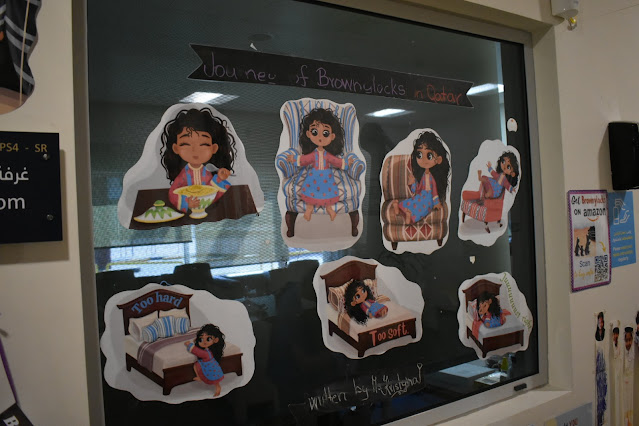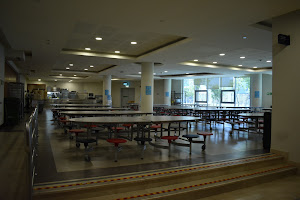Going to School
We had an incredible opportunity to visit with the students and staff at Tariq Bin Ziad School in Doha. The school administration was incredibly gracious to host us and to give us access to a day in their life. We arrived just as students were gathering for a morning assembly in the courtyard. The space was surrounded on three sides by the primary school and its classroom wings. The paved area was shaded by massive canvas tarps spread atop tall towering pillars that rose in the middle of the courtyard like alabaster trees. Students filed out in lines that were fairly orderly, though the song 'I Like to Move It' blaring out of loudspeakers tempted many to break rank and follow the command of the lyrics.
The school had a special celebration of reading that week, and the students were dressed up as book characters. Each class selected a book, and the student participation--and costume creativity--were impressive. Children dressed as safari animals, sea creatures, soldiers, and even weather joyously showed off their class themes. After watching the character parade, we were split into two groups to tour the school. The principal of the primary school took my group. We started in the preschool and had the opportunity to observe one class participating in music and another eating snack. Our tour introduced us to the school's history, its recent re-opening, its students, and its day-to-day operations. In the primary school, we witnessed several classes participating in their specials, and we dropped by the cafeteria, the library, and the school majlis. We rejoined the other half of our group to listen to the head of school give a presentation that went into more depth about the school's mission.
In the presentation, the administrators included two important concepts that guide the school. The first was "translanguage," where a dual-language approach facilitates instruction.The concept, "glocalization," refers to the goal of using local items and contexts to teach the international curriculum. Additionally, the school values community engagement by partnering with local groups and government ministries. They emphasized the significance of parental involvement, and concluded with a desire to "lead by love."
The Ministry of Education runs most of the schools in Qatar. Some campuses are run by the Qatar Foundation, which exists as a semi-governmental agency. QF schools have a greater diversity of options, including running the International Baccalaureate program, meeting the needs of students with autism, or focusing on particular topics like leadership or music.
Tariq Bin Ziad School began in the 1960s with only seven students and three teachers. It was one of only three schools in the country, at a time when only boys were educated. One of those early students was Hamad bin Khalifa Al Thani, member of the Qatari royal family and future emir. He later abdicated in 2013 to let his son take over. That is a very simplified account of a near-coup, but we're talking about an elementary school right now, not national politics. It was its status as the alma mater of the Emir Father that saved the Tariq Bin Ziad School from destruction. Starting in 2000, a plan was designed to rebuild the school, keeping its historical origins, but incorporating a new vision. The campus consists of a preschool and a primary school, housed in separate buildings.The school was gifted by the state to the Qatar Foundation, who now funds and manages it. The video below shows the historical and contemporary connections:
The building officially reopened in December 2019, just a few months before the COVID-19 pandemic shut the school back down. This school year is the first one that did not include large stretches of virtual or hybrid learning. The principal talked to us about the significant challenge to overcome the social, emotional, and learning difficulties that came from those stressful times. Hearing the universality of that current issue helped bridge the cultural gap between our experiences.
Tariq Bin Ziad School is certified by the International Baccalaureate as a Primary Years Programme. They use a translanguage model where students have two teachers, one in English and one in Arabic. At the preschool, those teachers team teach. In the primary school, students spend half the day with an English-speaking teacher and the other half with an Arabic-speaking one. English teachers also teach math, while Arabic teachers provide Islamic studies and Qatar history (required by the government). Both teachers are responsible for science, though it's known as "units of inquiry" in their curriculum. They also have specialists in music, art, media, and P.E.
Teachers come from an international background, which matches the mission of the school. They recruit faculty through job fairs, international education websites, and word-of-mouth. The international nature of the school's faculty is also a reflection of the nation's population. Teachers are paid well, though the two-tiered system for Qataris and expats was present here as well. Qatari teachers are paid between 35,000 and 60,000 riyals per month ($9600-$16,500). International teachers are paid approximately 20,000 riyals less.
Whole school assemblies are held each month, during which the principal focuses on one of traits of the IB learner profile. After the World Cup, for example, they focused on "reflection" and discussed ways that the soccer competition affect the nation and their lives. Students shared that they learned about new countries, especially in regards to their culture, dress, and flags. They also were able to find common practices between Qatar and other countries. In a country of 2.8 million people, only 300,000 of them are Qatari. The head of school, ethnically Qatari herself, shared that there is constant concern about losing their identity and culture to other groups. The experience of the World Cup, however, enabled Qatar to showcase itself to the world.
The school tries to make the international curriculum relevant to the local context in order to make learning more authentic. For example, one of the preschool classrooms read the fairy tale Goldilocks. The teacher inquired of the students how they would change the story to match Qatar's history. Students suggested that Goldilocks should have brown hair, she should wear a thoub, and she should live in a tent. The teacher, Kristyna, rewrote the story as Brownylocks and the Three Honey Badgers to show how her students re-envisioned the classic. When another class read about finding truffles, the teachers buried potatoes in the playground sand. Students were able to experience their own truffle hunt.
The school opened with students up to the third grade, but has been growing since then. There are currently 550 students, but the school is expecting to grow by an additional hundred students when they expand to 5th grade next year. Parents must apply to have their students attend the school, reminiscent of a charter school model in the United States. The children are tested in Arabic, English, and Math. Public schools cost 450 riyals to attend, but parents will spend up to 60,000 riyals to send their children to the Tariq bin Ziad School. Despite that price, the school is not private.
In terms of admission, the school currently prioritizes female students in order to balance their student body. Tariq Bin Ziad School was an all male school up until its relaunch, so greater efforts have been necessary to draw in female students. The imbalance was evident when we were watching the character parade. The classes were coed up until second grade, but most of the third and fourth grade classes were single sex. That separation is matter of necessity at the moment. When the school reaches its full capacity, the expectation is that they will have a more balanced enrollment. On an interesting note, the sex-based division will come into play when these students reach the next level. Middle schools in Qatar are coed, but classes are single-sex. So, a female student would interact with males students in the hallways and lunchroom, but they will only be in class with other girls.
Tariq Bin Ziad uses an integration model, bringing in five students from another school made up of students with autism. In doing so, the hope is to raise awareness among students and to increase inclusion. The special needs students spend most of their day in regular education, and then they spend some of their day in separate instruction.
The school day runs from 7 am until 1:15 pm. The school provides all snacks and meals for students while they are in session in order to guarantee that they are eating healthy food. Many policies of the school are still in flux. For example, they are thinking of adjusting the school day starting in April to account for the heat of the afternoon, when teachers and students start to drag. They may end the school day at 12 between April and October to mediate that effect.
Teachers start their day at 6:45, when they start welcoming students into their classrooms. After students leave at 1:15, teachers take a lunch break until 2pm. They spend the last hour of the day engaged in collaborative planning with their colleagues.
There were two panels from the school's wall of fame that I found summarized the school and its mission. I want to conclude by sharing their points below. My time at Tariq Bin Ziad School was moving and memorable. I loved seeing the joy of the students, the passion of the teachers, the pride of the administration, and the beautiful campus.

















